
On a blazing hot summer's day almost 80 years ago in Toronto's Beaches neighbourhood, hundreds of members of the Balmy Beach Swastika Club painted nazi symbols on their shirts, daubed anti-semitic slogans on two-foot placards, and took to the streets in an attempt to intimidate Jewish members of their community.
The Balmy Beach Canoe Club followed suit, prominently displaying a large outdoor swastika and painted "Heil Hitler." Throughout the property, blue and red signs were nailed to stakes or pinned to doors, the Toronto Telegram reported.
As the crowd marched through the east end in modified crimson and white sweat shirts flashing nazi salutes, a gift shop on Queen Street sold badges and other souvenirs bearing the appropriated symbol of a genocidal German dictatorship.
The events of that dark summer and a festering undercurrent of resentment among factions of Toronto's predominantly Protestant population would lead directly to the six-hour Christie Pits riot a few weeks later.
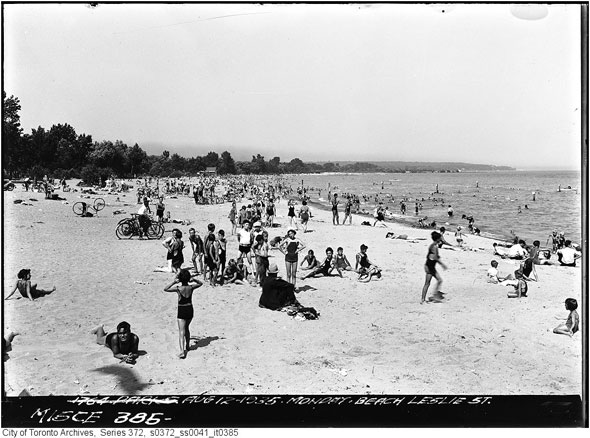
Acts of aggression and intimidation by radical members of Toronto's largely white, Protestant population toward Jewish newcomers were at all-time high in the depression years of the early 1930s. Though they made up just 7.2 per cent of people living in the city, the Jewish community was the second largest minority group at the time.
The Swastika Clubs, of which there were several, were careful not to specifically declare a distaste for any particular group, referring only to "the recent influx of obnoxious visitors," though witnesses to the groups and their actions knew the score.
"While the name 'Jew' is nowhere specifically mentioned in announcements or literature, prominent Toronto Jews have no hesitation declaring their belief that anti-Semitic action is the chief object of the Swastika Clubs," wrote the Telegram on 1 August, 1933.
By the time of the 1933 march, the six groups in old Ward 8 boasted a total of 400 members, according to newspaper reports that likened the various chapters to the Hitler Brown Shirts, the Nazi paramilitary wing that provided protection and intimidation on behalf of the larger political party.
Meyer Steinglass, the editor of the Jewish Standard, labeled the clubs "not merely threats to Jewish rights but to the democratic rights of all Canadians."
The store owner who was found selling nazi souvenirs was keen not to be identified when first approached by the Toronto Star. "One of the [Swastika Club] boys in here is selling them. He just works here, that's all," he claimed when quizzed about the 20-cent nickel pins.
"It is not a gang of hoodlums or an anti-Jewish organization. [The swastika] is merely a good luck emblem to give our organization good luck in gaining its objective" to keep the Beaches "clean and nice," he continued. The "Heil Hitler" signs were added afterwards by a third party as a joke, he insisted.
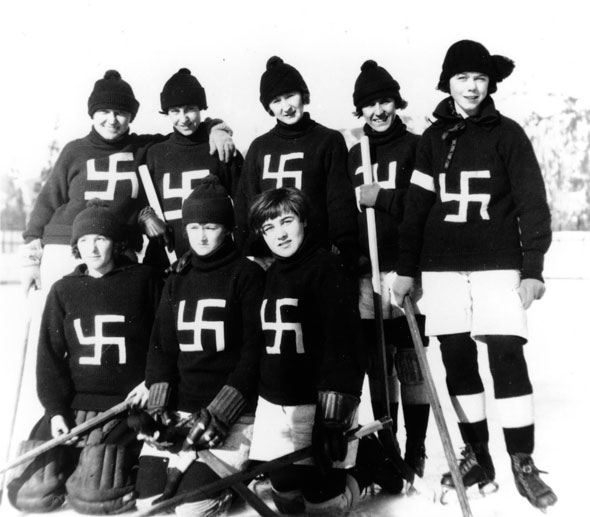
His protest isn't as ridiculous as it sounds. The swastika is an ancient symbol that dates back more than 5,000 years in the Mediterranean and Indian subcontinent. The word is derived from sanskrit and means "lucky" or "auspicious" and it was widely used in that way until the early part of the 20th century.
The hockey teams Windsor Swastikas, Fernie Swastikas (pictured above,) and town of Swastika, Ontario, located about 130 kms southwest of Timmins, are evidence of the original usage. The design was co-opted and rotated 45 degrees as a symbol of the Third Reich in Germany around 1920.
Civic officials for their part went some way to removing the nazi symbols and slogans from Toronto's public property. Rocks close to the beach and several park benches had to be taken away or repainted after the appearance of some hastily daubed symbol. On weekends, swastikas could be seen on sun clothes and swimsuits.
"The feeling is growing really tense," a Kew Beach goer prophetically observed. "So far there have been no violent clashes, but some day there is going to be one, and then I predict a real fight. Even the sea cadets are wearing the swastika sign on the back of their wind-breakers."
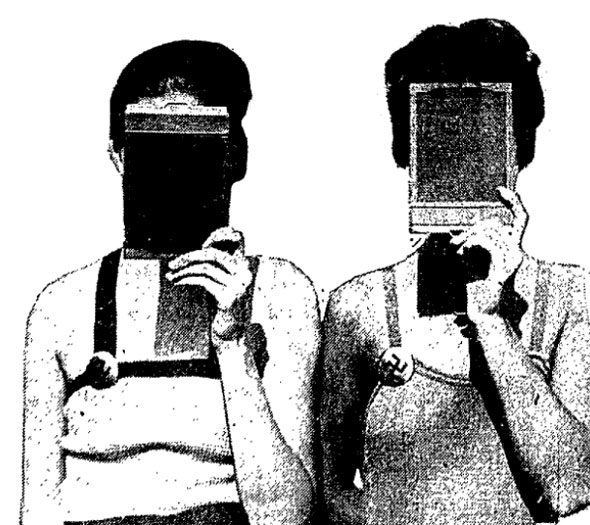 Following
front-page coverage in several of Toronto's newspapers, the clubs
quickly went underground. Seemingly all public signs vanished when it
was reported a march in support of the Jewish community would visit the
Boardwalk.
Following
front-page coverage in several of Toronto's newspapers, the clubs
quickly went underground. Seemingly all public signs vanished when it
was reported a march in support of the Jewish community would visit the
Boardwalk.Sensing a confrontation, young "Beachites" at a Balmy Beach clubhouse dance gathered lacrosse sticks and broom handles as the 500-strong group approached. Police at the Main Street station turned out in force as the rally paced around the outside of the party. Girls leaned out clubhouse windows and over the fence, watching tension build.
Another group, the "up-town gang," led by Al Kaufman, the "self-styled King of the Hoboes," arrived to add muscle to the nazi opposition. Kaufman walked ahead of his group with a large dog on a leash, the Star reported. When he passed the Balmy Beach club house his group were able to walk among the remaining dancers, the nazi devotees having moved elsewhere.
Kaufman and his gang would later case the neighbourhood for signs or posters but couldn't find any. As a precaution, the dance organizer decided to call it quits for the night before any trouble could start.
Mayor William James Stewart said the city would investigate claims of uncleanliness, a common gripe cited by the Swastika Clubs, but emphatically labeled the hate groups, however thinly veiled, "un-British and un-Canadian."
Tensions appeared to simmer down over the following days. The Balmy Beach Swastika Club claimed to have disbanded and editorials appeared in the Toronto papers denouncing the racist activity.
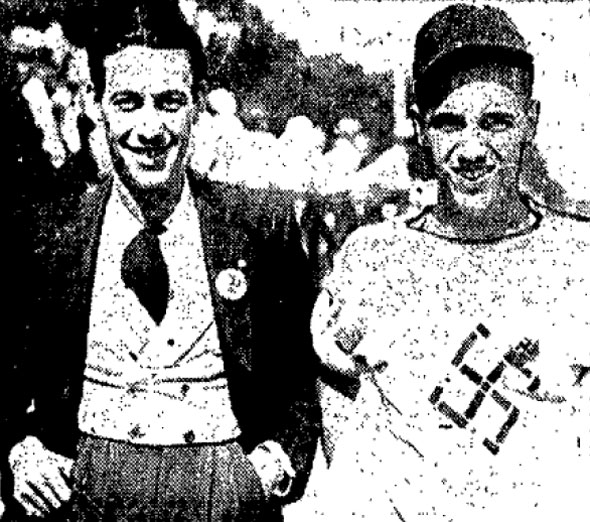
A few days later, the small confectionary shop at 2209 Queen East that sold the controversial pins became the focus of attention after it was reported to be the Swastika Club headquarters. Incensed, Bert Ganter, the owner, telephoned for police protection and, perhaps foolishly, declared that the club hadn't in fact disbanded.
"We are more determined than ever to keep the east end beaches free of obnoxious visitors," he spat. As he spoke, youths attracted by the police entered the back room and flashed "jocular" nazi salutes to each-other, the Star reported.
That weekend, a sunny day at the beach turned dark when fights broke out between Jewish and swastika-clad bathers. Shirts were ripped and signs destroyed in a series of scuffles before police stepped in.
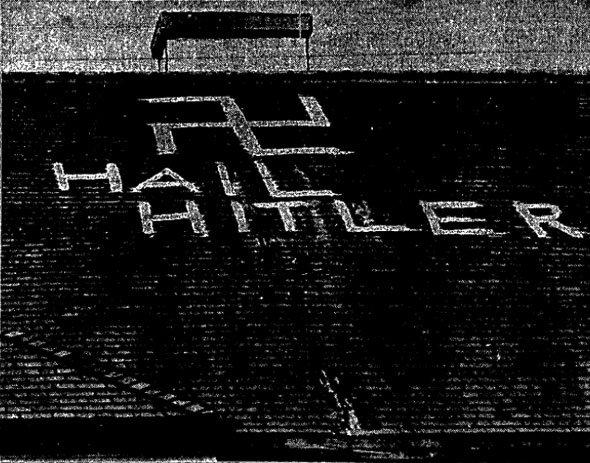
The Balmy Beach Swastika Club officially changed its name to the Beaches Protective Association but the tone of anti-semitism persisted. Worried, Toronto Star took the remarkable step of cabling Adolf Hitler in Germany to ask whether the Third Reich was behind the activity in Toronto's east end. The response came from Ernst Hanfstaengl, an aide and spokesman for the chancellor:
"Absurd to say Canadian anti-Jewish outbreaks in any way connected with the Nazi movement here," he wrote. "The Nazi movement is purely German and is unconnected with any other country."
It would be wrong to assume the sentiments were confined solely to the east end of the city. During a baseball match at Willowvale Park, now Christie Pits, between Harbord Playground, a Jewish team, and St. Peter's was disrupted when shouts of "Hail Hitler" rang from the bleachers. When the game almost ended in a fist fight, a large swastika was painted on the roof of the club house.
Two days later, the tinder box spectacularly ignited.
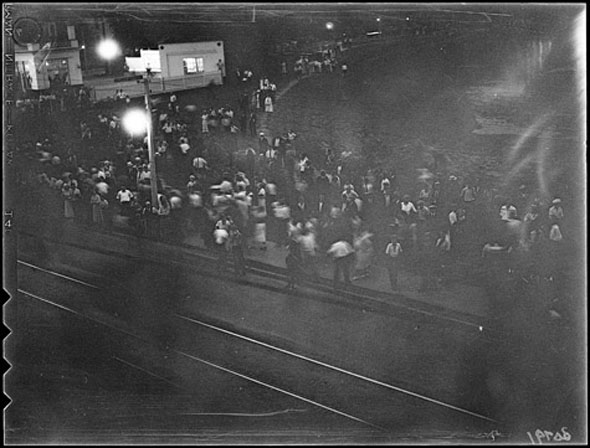
During a repeat match between the two baseball teams, a group of spectators raised a white flag bearing a nazi slogan and the game quickly descended into a brutal fistfight. Hearing about the brawl, gangs sympathetic to both sides flocked to the area wielding pipes, clubs, and other makeshift weapons.
"Heads were opened, eyes blackened, and bodies thumped and battered as literally dozens of persons, young and old, many of them non-combatant spectators, were injured more or less seriously by a variety of ugly weapons in the hands of wild-eyed and irresponsible young hoodlums, both Jewish and Gentile," the Toronto Star reported.
"From 7:30 o'clock to until nearly 2 a.m. the region in and around Willowvale Park surged with scenes of the wildest excitement ... squadrons of police, late to arrive on the scene, were hard pressed to handle the situation, which threatened to get completely beyond their control.
"Even when, resorting to the use of billies, horseback advances, and clouds of motorcycle exhaust smoke, they had succeeded in partially scattering the mob, the trouble-makers, and their curious throngs of spectators refused to disperse."
For six hours hundreds of people fought and attacked each other in a roiling mass of bodies that moved south down Montrose Avenue to an area north of College Street. When the dust settled just two people had been arrested but scores were in hospital with head injuries, facial lacerations, cuts, and bruises.
The only person charged with a crime, Jack Roxborough, had to pay $50 for carrying an offensive weapon. A charge for carrying a knife against one Russel Harris, 23, was laid but later dropped.
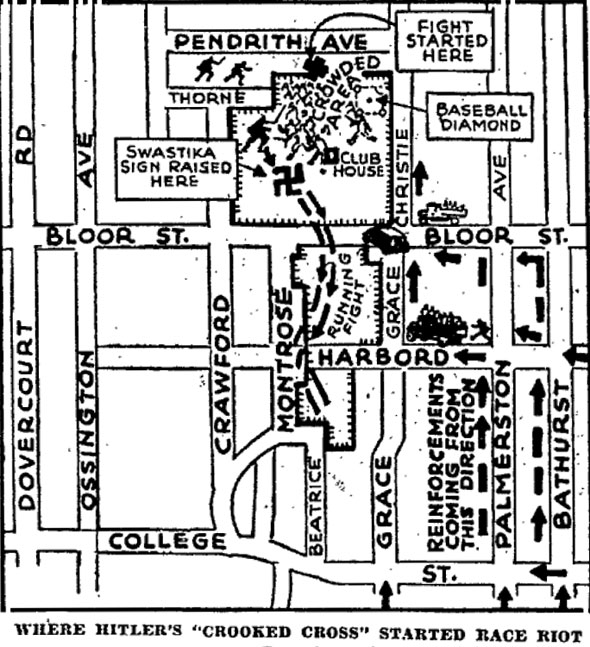 Angered
at the clumsy police response to what had been clearly an escalating
period of tensions, Mayor Stewart warned that anyone displaying a
swastika in Toronto would be subject to immediate prosecution, even Boy
Scouts who were using the sign in its original, peaceful form on one of
their patches weren't exempt.
Angered
at the clumsy police response to what had been clearly an escalating
period of tensions, Mayor Stewart warned that anyone displaying a
swastika in Toronto would be subject to immediate prosecution, even Boy
Scouts who were using the sign in its original, peaceful form on one of
their patches weren't exempt.Local leaders called for police chief Dennis Draper to resign when Elmore Philpott, a politician and journalist, revealed just six officers were on hand at Willowvale that night while two hundred were occupied with dispersing a peaceful meeting at Trinity Bellwoods Park. He stayed, however.
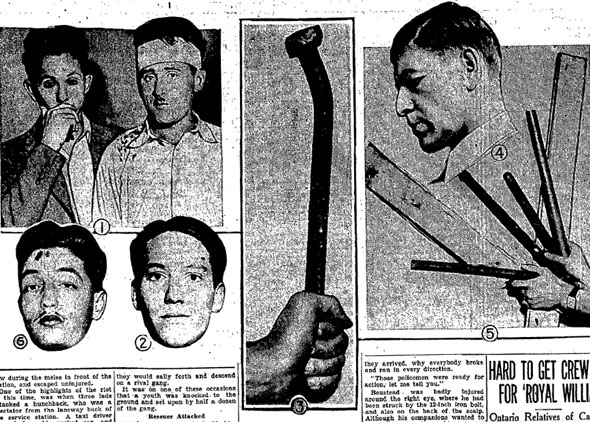 Later
in August 1933, a handful of Jewish people were accepted as prospective
members of the Beaches Protective Association during a meeting held at
Kew Beach public school.
Later
in August 1933, a handful of Jewish people were accepted as prospective
members of the Beaches Protective Association during a meeting held at
Kew Beach public school. In a return to their stated aim of beautification, the members decided the Beaches required more police and that men should not be allowed to roll their bathing suits down to the waist in public.
Mr. Ganter, the candy store owner who sold the inflammatory paraphernalia, admitted that several financial backers of the Protective Association had withdrawn over the negative press. Undeterred, he announced plans to start a new faction that would continue the Swastika Club's original aims.
Though the movement would continue, tensions never erupted as spectacularly as they did at Christie Pits that August night, though swastikas still occasionally appear on the Boardwalk today.
Please share this
No comments:
Post a Comment